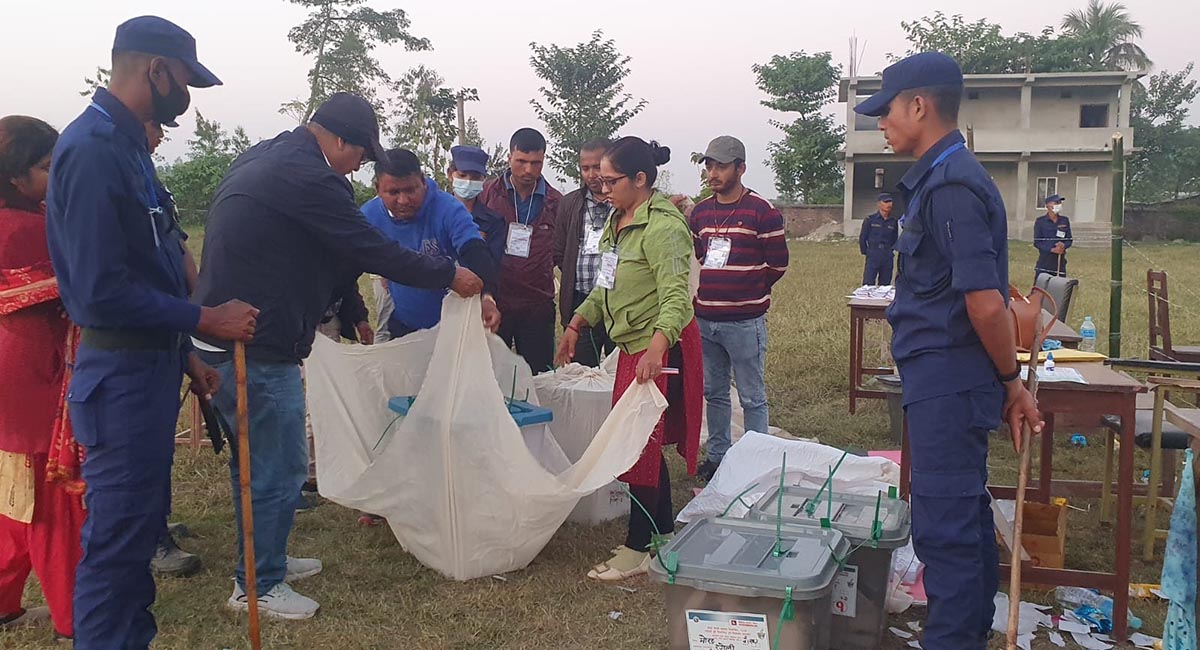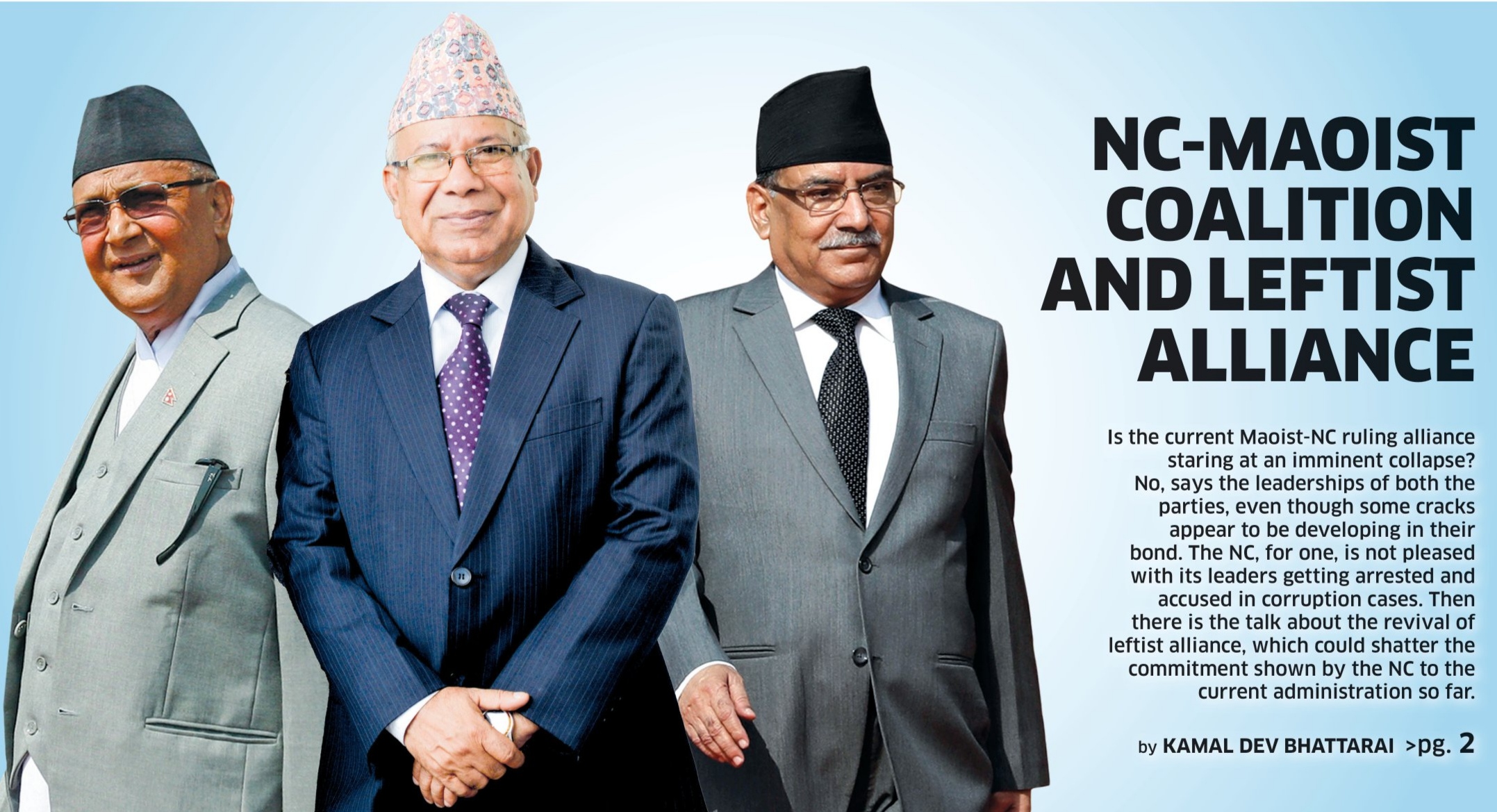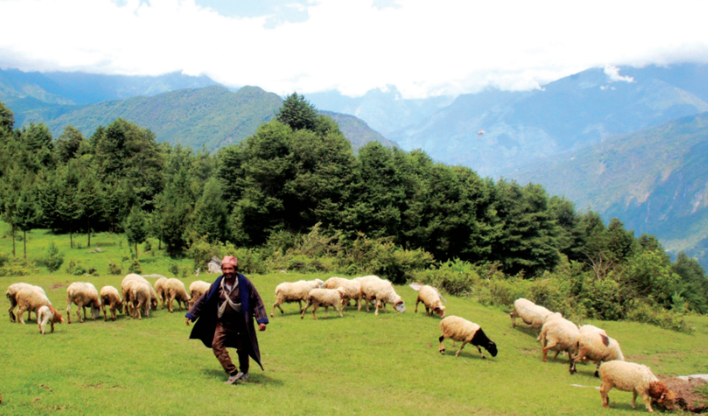Shekhar Chandra Thapa: A life cut short
Shekhar Chandra Thapa, Minister of Forests and Environment of Province 1 and provincial assembly member candidate of the Nepali Congress from Morang-3 is no longer with us. He was 58. He fell ill soon after his candidacy for the recently concluded election was confirmed, and he passed away just a few days after filing his nomination. Born in Morang, Thapa graduated from Durbar High School in Kathmandu. Since then, he made a name for himself in politics. He first got into politics as the Deputy Secretary of Nepali Congress-Morang. He was also the personal secretary to former prime minister Girija Prasad Koirala. He also contested the Constituent Assembly election in 2013, but he lost to CPN-UML leader Chandi Rai. “We were together in every election as far as I can remember,” says Dila Sangraula of the Nepali Congress. Thapa was previously elected as one of the members of the Provincial Assembly through the proportional system in the 2017’s election, but this time he was up for candidacy through the first-past-the-post system. Sangraula says that Thapa was quite tense about the recently concluded election. He wanted to be among his supporters but he hadn’t been keeping too well and couldn’t be actively involved in the election campaigns. On Oct 9, Thapa complained of uneasiness and was taken to Biratnagar-based Nobel Hospital. He tested positive for dengue, pneumonia, and piles. He was then airlifted to Kathmandu on Oct 13 for further treatment. After almost a month-long treatment at HAMS Hospital in Kathmandu, he returned to Biratnagar. On Nov 7, a day after he filed his nomination for the election, he was again admitted to Nobel Hospital in Biratnagar as he had respiratory problems. It was here that he passed away two days later on Nov 9. Chief Minister Rajendra Kumar Rai of Province 1 expressed his sorrow. PM Deuba also extended his condolences to the family. The Election Commission announced that it would carry on with the provincial election in Morang as planned, with Man Bahadur Limbu replacing Thapa. Sangraula of the Nepali Congress says Thapa had contributed a lot during his time with the party—he was a pillar of strength and support. But Thapa still had a lot to do and his wife is determined to carry out his wishes as one of the members of the party. Besides his wife, he leaves behind a son and a daughter. Birth: 1964 Death: 9 Nov 2022
Anti-incumbency forces challenge Nepal’s old parties
Vote counting for the Nov 20 elections is underway across 165 constituencies. And if the preliminary count is anything to go by, independent and new party candidates are likely to give old established parties the run for their money. As of Nov 21 evening, Rastriya Swatantra Party (RSP), a new party led by former TV host Rabi Lamichhane, was ahead in several constituencies including in Kathmandu Valley. Nepali Congress was leading in more than three dozen constituencies, CPN-UML in 18, and RSP in eight. For a new party like the RSP, to hit the ground running like this suggests that major political parties can no longer rely on their traditional voter base to win their elections. There was a time when elections used to be a three-horse race between Nepali Congress, CPN-UML, and CPN (Maoist Center). In Madhes Province, these three parties compete against the Madhes-based parties. Not anymore. New parties and independent and RSP candidates are posing tough challenges to the ‘heavyweights’ of old political parties. Similarly, young faces of major political parties are leading in several constituencies. These two trends clearly give a strong message: people are frustrated with old faces and they want to see new faces at the helm of politics. Major parties NC and UML are unlikely to face a major loss in this election but it serves as a big warning to them to mend their ways. NC is likely to emerge as the largest party from elections followed by CPN-UML. Preliminary counting shows Maoist party is unlikely to fare well in the urban areas. The party is likely to win seats in the mid-west, Madhes, and in the hilly district. Nepal’s Nov 20 parliamentary and provincial assembly elections registered a voter turnout of 61 percent, 7 percent below than 2017 national elections. In every election after 2008, a new trend is emerging. In 2008, the former rebel Maoist party unexpectedly emerged as the largest party. In the second Constituent Assembly elections held in 2013, Rashtriya Prajatantra Party, a royalist party, secured 25 seats in the Constituent Assembly. In 2017, parliamentary elections then left the alliance of CPN-UML and CPN (Maoist Center) secured almost two-thirds votes. This time, RSP and some independent candidates are likely to make their presence in the national parliament.
Himalaya Shumsher Rana: Economist par excellence
Quick facts
Born on 8 Jan 1928 in Kathmandu
Went to Durbar High School, Kathmandu
Graduated from St Xavier’s College
Post-grad from Bombay University, India
Joined Ministry of Finance in 1951
Husband of Vijayalaxmi Malla
Father to Pratima Pande, Ashok Rana, Sangeeta Thapa, and Amar Rana
 As a great-grandson of Rana Prime Minister Dev Shumsher, I had a very privileged life. I was conferred with the rank of lieutenant colonel of the army at a young age, and I got a good education. I went to Bombay for higher studies.
It was during my student life in India, I witnessed first-hand the anti-British movement, which encouraged me to become a democrat and rebel against my own family, who belonged to the feudal ruling class.
After my master's degree, I returned to Nepal. At that time, the government was seeking economics scholars for the finance ministry. I, along with three other people, was the only economics student in Nepal, and all of us were appointed to the ministry in 1951.
In the next two months, I became the finance secretary out of my four peers based on my performance. There was no such position like the finance secretary before me. There was also no system of announcing the national budget and bringing out a national expenditure report.
I served as the finance secretary for five years, and during my tenure, the ministry introduced many economic reforms. I prepared the national budget and increased the government sources. At that time, the government’s income mainly came from land revenue, which was not enough. So the ministry came up with new financial regulations and modernized the customs depots in Biratnagar, Bhairahawa, Birgunj and other places to increase the government’s revenue. The ministry also established the Income Tax Department and Excise Department.
In 1952, I was part of the Prime Minister Matrika Prasad Koirala’s delegation to India. During the visit, I proposed a trading deal with India. The Indian government used to levy tax on the goods produced there, and when the same goods were bought in Nepal, the Nepalis would have to pay double tax. So, I asked the Indian government to remove the tax. It took around four years to implement the proposal. Nepal received Rs 30m annually as a refund.
After a successful tenure as a finance secretary, I was offered the job of the governor at Nepal Rastra Bank by the then King Mahendra. There was no central bank in the country yet, so the king gave me a book that had a draft of the Banking Act. But I requested the king that I would need some time to study the act of central banks of foreign countries and only start the process of establishing the central bank in Nepal. Until then, I would work as an officer on special duty. My request was granted.
At first, I established a central office, an office for banking transactions, and a note department. After almost six months of homework, I was appointed as the governor on 26 April 1956. With a small team, we started working to realize King Mahendra’s aim. He had two major concerns: to introduce Nepali notes in Tarai, and stabilize an exchange rate between Rs and InRs.
[caption id="attachment_34424" align="alignnone" width="1024"]
As a great-grandson of Rana Prime Minister Dev Shumsher, I had a very privileged life. I was conferred with the rank of lieutenant colonel of the army at a young age, and I got a good education. I went to Bombay for higher studies.
It was during my student life in India, I witnessed first-hand the anti-British movement, which encouraged me to become a democrat and rebel against my own family, who belonged to the feudal ruling class.
After my master's degree, I returned to Nepal. At that time, the government was seeking economics scholars for the finance ministry. I, along with three other people, was the only economics student in Nepal, and all of us were appointed to the ministry in 1951.
In the next two months, I became the finance secretary out of my four peers based on my performance. There was no such position like the finance secretary before me. There was also no system of announcing the national budget and bringing out a national expenditure report.
I served as the finance secretary for five years, and during my tenure, the ministry introduced many economic reforms. I prepared the national budget and increased the government sources. At that time, the government’s income mainly came from land revenue, which was not enough. So the ministry came up with new financial regulations and modernized the customs depots in Biratnagar, Bhairahawa, Birgunj and other places to increase the government’s revenue. The ministry also established the Income Tax Department and Excise Department.
In 1952, I was part of the Prime Minister Matrika Prasad Koirala’s delegation to India. During the visit, I proposed a trading deal with India. The Indian government used to levy tax on the goods produced there, and when the same goods were bought in Nepal, the Nepalis would have to pay double tax. So, I asked the Indian government to remove the tax. It took around four years to implement the proposal. Nepal received Rs 30m annually as a refund.
After a successful tenure as a finance secretary, I was offered the job of the governor at Nepal Rastra Bank by the then King Mahendra. There was no central bank in the country yet, so the king gave me a book that had a draft of the Banking Act. But I requested the king that I would need some time to study the act of central banks of foreign countries and only start the process of establishing the central bank in Nepal. Until then, I would work as an officer on special duty. My request was granted.
At first, I established a central office, an office for banking transactions, and a note department. After almost six months of homework, I was appointed as the governor on 26 April 1956. With a small team, we started working to realize King Mahendra’s aim. He had two major concerns: to introduce Nepali notes in Tarai, and stabilize an exchange rate between Rs and InRs.
[caption id="attachment_34424" align="alignnone" width="1024"] Rana at Nepal Rastra Bank’s office.[/caption]
During those days, the Nepali currency was not in use in the Tarai, so much so that it was customary to take the land revenue and immigration duties in Indian currency. In such a situation, replacing Indian notes with Nepali ones was a challenging task.
Unless there was a stable exchange rate between Rs and InRs, it was not possible to circulate Nepali currency in the Tarai. We researched for three years and came up with the exchange rate of Rs 160 for InRs 100. To date, we use the same rate. We then established currency exchange centers from East to West.
Some moneylenders were upset with this decision, as they used to buy InRs at a cheap price from Nepalis in foreign employment and sell them at a high price during Dashain shopping. Though it was a tough task, we were able to do a revolutionary job of circulating Nepali currency in the Tarai. These days, I sometimes wonder how we managed to achieve the task in such a short period.
Nepali notes were printed at Nashik Security Press in India back then. After the establishment of the central bank, we called for an international tender because we had to revise the notes that were being printed from India. A proposal from a company from the UK was the best. It came up with a new design for notes bearing the pictures of famous places of Nepal. It was very nice and attractive. The notes printed in India also did not have the security thread; it was added on to the notes printed in the UK.
After I served as the governor for four years and eight months and almost two months since King Mahendra banned political parties and started a dictatorial regime, I was sacked on 8 Feb 1961 because I was a supporter of democracy.
Soon after the king took absolute power, the Nepali economic situation started going bad. I requested the king to reappoint me, but to no avail. I waited for several months and then decided to work for the United Nations. I worked in Pakistan, Sri Lanka, America, Afghanistan, Myanmar, and Indonesia.
Ever since I became the finance secretary, I have worked tirelessly. After retirement, I tried to spend my time playing golf and reading books. But I got bored after six months and decided to start a business. I established Gorkha Brewery Company and brought international beer brands like Tuborg and Carlsberg to Nepal. I also established the first private bank in Nepal, Himalayan Bank Ltd.
Rana at Nepal Rastra Bank’s office.[/caption]
During those days, the Nepali currency was not in use in the Tarai, so much so that it was customary to take the land revenue and immigration duties in Indian currency. In such a situation, replacing Indian notes with Nepali ones was a challenging task.
Unless there was a stable exchange rate between Rs and InRs, it was not possible to circulate Nepali currency in the Tarai. We researched for three years and came up with the exchange rate of Rs 160 for InRs 100. To date, we use the same rate. We then established currency exchange centers from East to West.
Some moneylenders were upset with this decision, as they used to buy InRs at a cheap price from Nepalis in foreign employment and sell them at a high price during Dashain shopping. Though it was a tough task, we were able to do a revolutionary job of circulating Nepali currency in the Tarai. These days, I sometimes wonder how we managed to achieve the task in such a short period.
Nepali notes were printed at Nashik Security Press in India back then. After the establishment of the central bank, we called for an international tender because we had to revise the notes that were being printed from India. A proposal from a company from the UK was the best. It came up with a new design for notes bearing the pictures of famous places of Nepal. It was very nice and attractive. The notes printed in India also did not have the security thread; it was added on to the notes printed in the UK.
After I served as the governor for four years and eight months and almost two months since King Mahendra banned political parties and started a dictatorial regime, I was sacked on 8 Feb 1961 because I was a supporter of democracy.
Soon after the king took absolute power, the Nepali economic situation started going bad. I requested the king to reappoint me, but to no avail. I waited for several months and then decided to work for the United Nations. I worked in Pakistan, Sri Lanka, America, Afghanistan, Myanmar, and Indonesia.
Ever since I became the finance secretary, I have worked tirelessly. After retirement, I tried to spend my time playing golf and reading books. But I got bored after six months and decided to start a business. I established Gorkha Brewery Company and brought international beer brands like Tuborg and Carlsberg to Nepal. I also established the first private bank in Nepal, Himalayan Bank Ltd.
 About him
Sangeeta Thapa (Daughter)
About him
Sangeeta Thapa (Daughter)
 My father is my hero. He has treated me as his best friend. Though he was engaged in professional life most of the time, he always made time for his children. He would take interest about our life and our studies. He inspired me and my siblings to work hard to find success. He also has a huge interest in art and literature, and I feel that I got involved in the field of arts because of him.
Kiran Pyakurel (Friend)
My father is my hero. He has treated me as his best friend. Though he was engaged in professional life most of the time, he always made time for his children. He would take interest about our life and our studies. He inspired me and my siblings to work hard to find success. He also has a huge interest in art and literature, and I feel that I got involved in the field of arts because of him.
Kiran Pyakurel (Friend)
 We have been friends since we were working for the United Nations. He is an admirable man. Despite being born to a Rana family, he always advocated for democracy, which also cost him the post of governor. I am inspired by how he never lost his learning spirit and has managed to remain curious all his life. No matter his age, he is always curious to learn about new things.
Rabi Singh (Family friend)
We have been friends since we were working for the United Nations. He is an admirable man. Despite being born to a Rana family, he always advocated for democracy, which also cost him the post of governor. I am inspired by how he never lost his learning spirit and has managed to remain curious all his life. No matter his age, he is always curious to learn about new things.
Rabi Singh (Family friend)
 I have known many high profile individuals in my life, but no one as polite and down to earth as Himalaya Shumsher Rana. It is all thanks to him that Nepal underwent many financial reforms. There are many things we can still learn from him. He is a man who could have been one of the richest people of Nepal, but he didn’t care about wealth. He is certainly wealthy, but he has always lived a simple life, which is inspirational.
I have known many high profile individuals in my life, but no one as polite and down to earth as Himalaya Shumsher Rana. It is all thanks to him that Nepal underwent many financial reforms. There are many things we can still learn from him. He is a man who could have been one of the richest people of Nepal, but he didn’t care about wealth. He is certainly wealthy, but he has always lived a simple life, which is inspirational.
Why did Nepal see low voter turnout this time?
Nepal’s Nov 20 parliamentary and provincial assembly elections registered a voter turnout of 61 percent, according to the Election Commission (EC). Speaking at a press conference, Chief Election Commissioner Dinesh Thapaliya said voter turnout fell below expectations. The highest turnout (78 percent) was recorded in the second Constituent Assembly (CA) elections in 2013, while the lowest was in the parliamentary elections of 1993 (61 percent) and the first CA election in 2008 (61percent), respectively. In the 2017 parliamentary and provincial assembly elections, the turnout of voters was decent at 68.67 percent. In the local-level elections held in May this year, voter turnout was 66.86 percent. Voter turnout this time, however, was much lower, even though there were no major security threats to the elections. In 2017, people were excited to vote because they had hoped the elections would lead the country toward political stability and prosperity. But that was not to be. Some analysts say the post-2017 political scene was the very reason why many voters did not cast their ballots this time. Chandra Dev Bhatta, a political analyst, says lower turnout was expected right from the very beginning when major political parties country began allocating tickets. The parties distributed election tickets to their near and dear ones, as they had been doing since the 1990s. Many candidates were familiar faces who even after winning the elections had delivered little, if nothing, to their constituencies over the last three decades. “The voters, irrespective of their age and political persuasion, this time wanted to see new candidates who could bring about real change,” says Bhatta. “But that didn’t happen when the parties announced their candidates.” Another reason for low voter turnout, says Bhatta, was the fact that the election this time was not conducted on any specific agendas, ones connected to the livelihood of the people. “Major parties tried to trump up the rumor that if they didn’t win the election this time, the country’s democracy, sovereignty, and the constitution itself would be endangered,” says Bhatta. “Of course, the discerning voters didn’t buy this bluff.” In fact, declining voter turnout is a global trend. According to a study carried out by IDEA International in 2016, despite the growth in the global voter population and the number of countries that hold elections, the global average voter turnout has decreased significantly since the early 1990s. Global voter turnout, says the report, was fairly stable between the 1940s and the 1980s, falling only slightly from 78 percent to 76 percent over the entire period. “It then fell sharply in the 1990s to 70 percent and continued its decline to reach 66 percent in the period of 2011–15.” This is most definitely not because the voters are not interested in politics. Analysts say it is perhaps because voters no longer identify with their politicians. Voter turnout in the previous elections 1991: 65.15 percent 1993: 61.86 percent 1999: 65.79 percent 2008: 61.7 percent (FPTP) and 63.3 percent (PR) 2013: 78.74 percent (FPTP), 79.82 percent (PR) 2017: 68.67 percent 2022: 61 percent



















